That decision will likely prove painstaking for many businesses and advanced home networks trying to optimize performance and scalability. Choosing the right networking equipment is a crucial decision for any institution. A 16-port gigabit Ethernet switch is one of the standout devices that is competent in dealing with a myriad of wired connections while transferring data at a high speed. His entire product feature set and other products on offer drive the question of their distinguishing factors. In this piece, we look at making the selection of 16-port gigabit Ethernet switches easier with crucial performance metrics and reliability paired with advanced features and budget. If you’re setting up a small office network, upgrading your infrastructure, or increasing the body of devices, this guide will arm you with the knowledge to make these decisions with ease.
What is a 16-port gigabit ethernet switch?
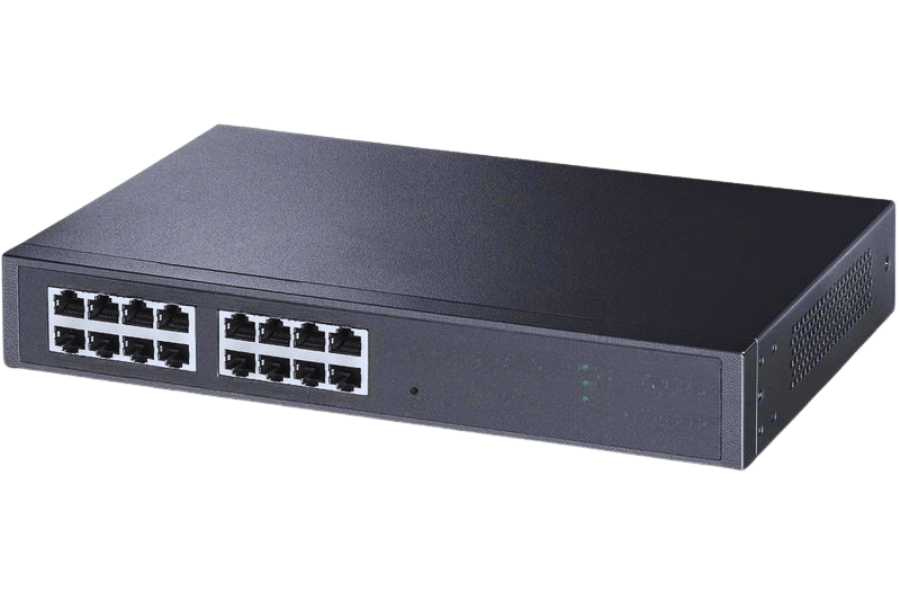
A 16-port Gigabit Ethernet switch facilitates connections among devices, including computers, printers, and servers, within a local area network (LAN). Each of the 16 ports can transfer data rates of 1 Gigabit per second. A switch of this nature manages effective communications among devices by sending data packets to each device without collisions. Such a switch is preferable in small to medium-sized networks, which require enhanced performance, traffic management, and high-speed connectivity.
Understanding the basics of gigabit ethernet
Gigabit Ethernet is a networking standard for data transmission supporting speeds of up to one gigabit per second (Gbps). It uses both wired and optical connections, guaranteeing rapid communication for contemporary network needs, especially at 16-gigabit speeds. This technology is optimal for video streaming, large file transfers, and online collaboration, as it lowers latency while boosting performance and bandwidth. Gigabit Ethernet also works with previous Ethernet standards, making it easy to incorporate into already established systems.
How does a 16-port gigabit switch work?
A 16-port gigabit switch connects several devices within a local area network (LAN), enabling data communication at 1 Gbps per port. Each port on the switch is configured to automatically recognize the speed and type of device connected to it, consequently affecting how data is transmitted. The switch functions on the principle of packet switching. Here, data is stored in packets and is subsequently sent out only to the device with the corresponding MAC address, which resides on the switch. This strategy makes good use of the gigabit ports. It prevents data collisions as well as minimizes congestion, which enhances the overall performance of the network. For this reason, a switching solution for small to medium-sized networks is often ideal.
Benefits of using a 16-port gigabit switch
- Improved Network Speeds: Supports elevated data transfer with bandwidth-intensive functions like streaming videos and sharing super-sized files, giving up to gigabit speeds.
- Scalability: Allows up to 16 users to connect simultaneously, making it easier to scale the network as needed.
- Reduced Network Congestion: Enhances performance by optimizing data flow to eliminate traffic jams and improving overall data routing.
- Cost-Effective Solution: This solution provides a reliable network that does not strain resources while enhancing network capacity.
- Ease of Use: User-friendly due to low configuration complexity for residential or commercial small to medium networks.
How to choose the right network switch for your needs?
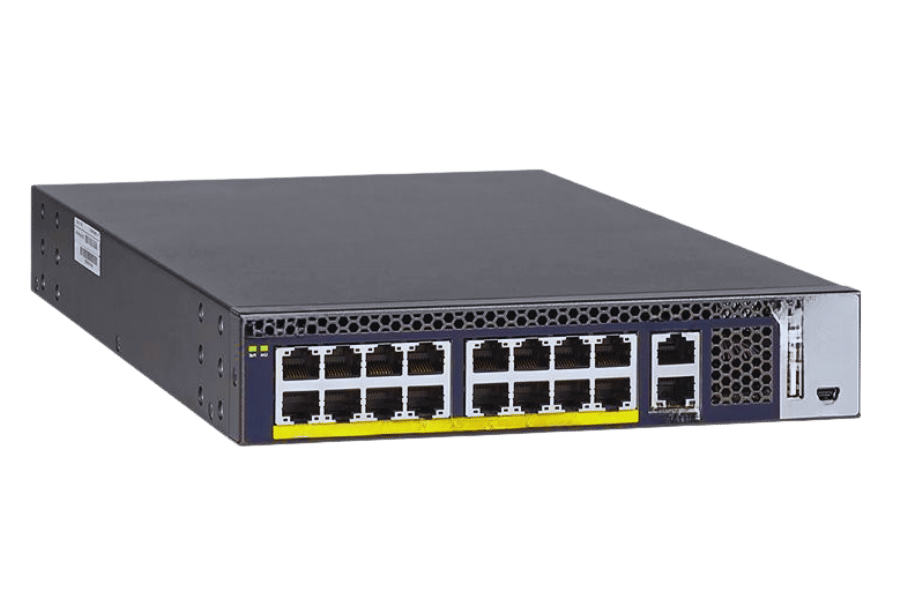
Key features to look for in an ethernet switch
- Port Count: Evaluate how many devices you need to connect and select a switch with enough ports to satisfy your current needs and future growth.
- Speed Capability: Choose a switch with Gigabit Ethernet capability to increase the speed of data transfer for activities requiring greater bandwidth, such as video streaming or sharing large files as needed.
- Managed vs. Unmanaged: Complex networks require high control and security offered by managed switches. Unmanaged switches are much easier to configure and maintain and are better suited for less complex networks.
- Power over Ethernet (PoE): If you need to power devices such as IP cameras or wireless access points, search for switches supporting PoE.
- Build Quality and Reliability: Select a trustworthy brand with solid construction to ensure dependability over time and the least disruptions.
Difference between managed switch and unmanaged switch
Managed switches monitor the network, maintain configurations, and control traffic, which is suitable for complex networks or larger organizations. Unmanaged switches do everything automatically and require no configuration, which is ideal for smaller networks with fewer demands and offers a plug-and-play solution. The distinction between the two types is the amount of control and flexibility that is granted; managed switches have more intricate capabilities in comparison to unmanaged, which favors simplicity.
Importance of power over ethernet (PoE) in modern networks
Power over Ethernet (PoE) technology is an integral part of modern networks because it simultaneously enables power and data transmission over an Ethernet cable. With PoE enabled, separate power supplies are no longer needed for devices like IP cameras, wireless access points, and VoIP phones, improving infrastructure. Moreover, PoE lowers capital expenditures, increases device placement versatility, and enables expansion in small—to medium-sized network deployments. Due to its effectiveness and dependability, it has become a significant feature of modern networking technologies.
Installation and setup of a 16 port gigabit ethernet switch
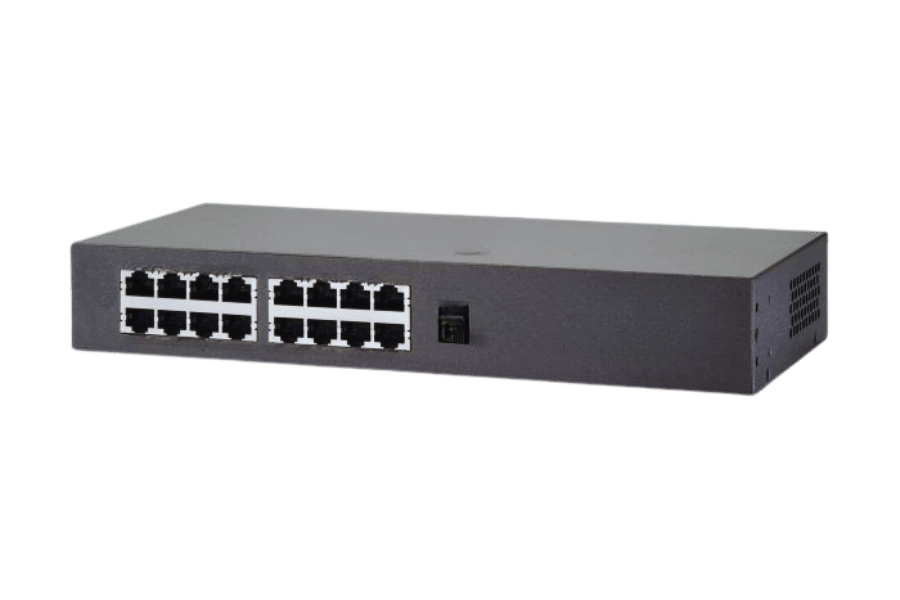
A step-by-step guide to installing your 16-port gigabit ethernet switch
Step 1: Unbox and check the switch
Take the switch out of its box and check the list of components, which include the power cord, instructional guide, and mounting hardware. Check the switch for any signs of damage.
Step 2: Pick a suitable area
Designate a safe area with proper airflow for placing or mounting the switch. The location must be accessible to the power supply and the devices that need to be connected, especially with PoE ports.
Step 3: Place or mount the switch
For rack-enabled switches, secure the switch to the rack with the brackets provided. For desktop switches, set the switch on stable flat surfaces.
Step 4: Plug in the power supply
Connect one end of the power cable to the switch and the other end to the outlet. Power the switch and make sure the power light goes on. This indicates that the switch is on and working correctly.
Step 5: Attach Ethernet cables
Connect Ethernet cables to the switch ports for each device that needs to be connected. Make sure each cable is securely plugged in to establish a stable connection.
Step 6. Set up all necessary network connections
Connect your primary router or modem to the switch through an ethernet port using an ethernet cable. This way, the switch joins your network and gains access to the internet.
Step 7. Check ethernet connectivity status
Ensure all indicator lights of the selected ports are active to ensure correct connections. Confirm that all devices on the network are operational, especially those linked via PoE ports.
Step 8. Modify settings if needed
Use the instruction guide provided with the switch to access its configuration interface and make the needed changes specific to your switch, such as VLANs or QoS for your network.
Step 9. Make final verification and control changes
Check the indicator lights of all devices linked to the switch and confirm they are on. Check and confirm network traffic from and to the computer systems is being carried out efficiently and effectively.
Tips for a successful plug-and-play setup
- Read the documentation: Read the vendor’s user manual or installation guide to learn what to do and what to recommend about the device.
- Ensure proper cables are used: Reliable and high performance are achieved using appropriate Ethernet cables.
- Check power supply: Make sure the power source is reliable and capable of delivering the needed voltage for the unit.
- Update firmware if necessary: Check the switch firmware version to ensure that it is current to not have any compatibility issues or security risks.
- Label connections: Devices and ports’ identification is crucial for easier diagnosis and maintenance in the future, which is why they should be labeled clearly.
- Test before deployment: Before deployment, test the new equipment within a controlled environment to ensure it works with the primary network and VLANs.
What are the advantages of using a 16-port gigabit ethernet switch with two uplinks?
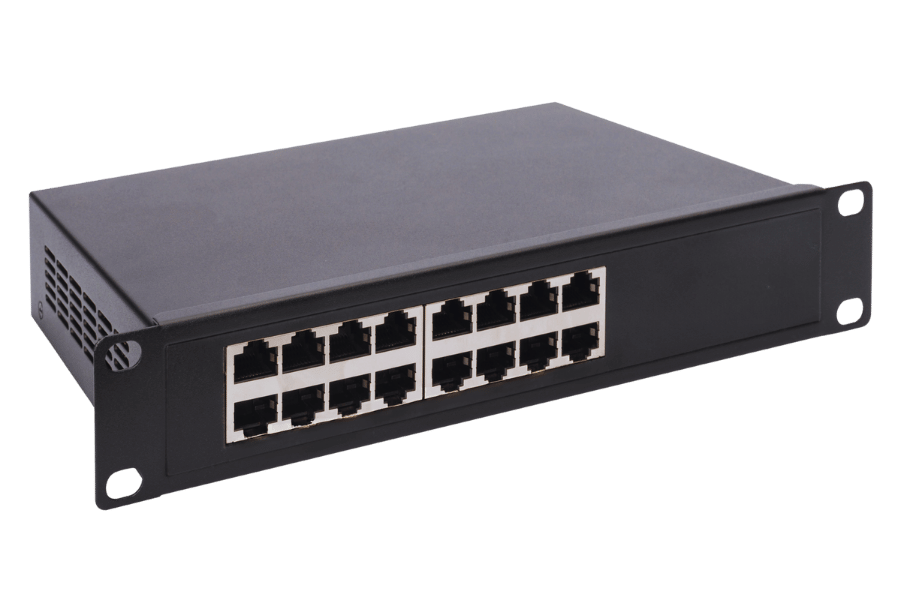
Enhanced network flexibility with uplink ports
Superior network devices such as routers or core switches can now be easily used with a 16-port gigabit Ethernet switch with two upcoming uplink ports. These switches equip uplink ports, which aid in the performance of bandwidth-intensive applications by providing faster data transfer, ensuring smoother performance. They also facilitate simpler network modulation whereby more switches or devices can be integrated without affecting the existing infrastructure. Because of these reasons, switches with uplink ports effectively scale networks and optimize connectivity in small and medium-sized environments.
Boosting gigabit speeds in your network environment
Integrating two uplinks with a 16-port Ethernet switch enhances the speed of the whole network to gigabit levels. Communication between devices within the same network is much faster and more reliable due to the support of gigabit ethernet technology, which enables devices to transfer data at a rate of one thousand megabytes per second. These switches, combined with uplink ports, aid in merging traffic onto high-capacity network segments, thus decreasing bottlenecks and improving overall bandwidth allocation, which positively affects most areas of network performance.
Another critical aspect in achieving high speeds is the selection of the proper cabling, such as CAT6 or higher-rated Ethernet cables, capable of supporting gigabit transmission over long distances with minimum signal degradation. Critical data traffic such as voice over IP and video streaming can have enabled features like Quality of Service (QoS), which assures them of guaranteed seamless bandwidth for smooth operations. Another feature of modern switches is support for Energy Efficient Ethernet (EEE), which, when the network is switched to low activity mode, diminishes power consumption and thus improves operational costs without hindering speed. These various features and technologies allow businesses to implement a scalable network capable of coping with the challenges of data-intensive applications at high performance.
Common troubleshooting tips for gigabit ethernet switches
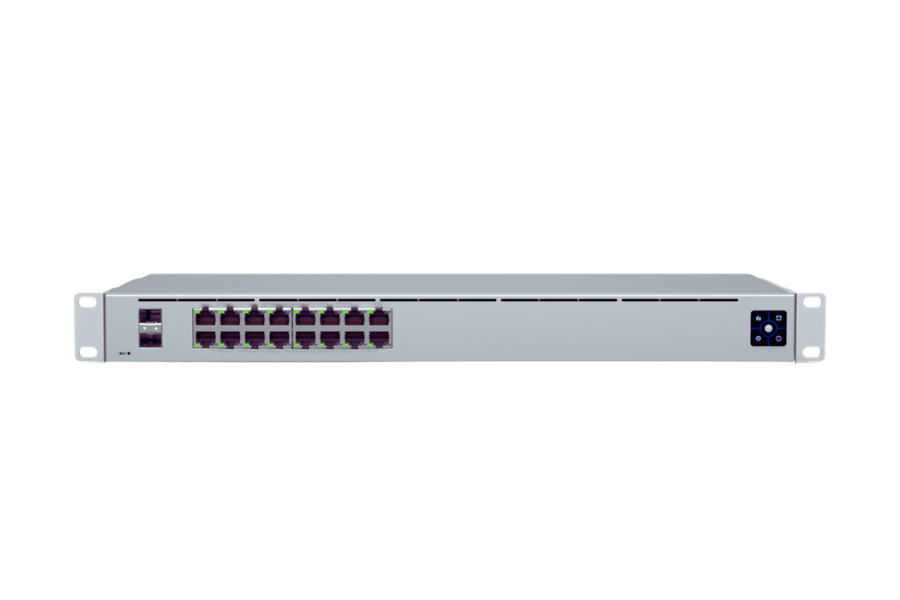
Identifying and resolving issues with ethernet ports
- Check physical connections: Double-check that the Ethernet cable is correctly connected to the switch and the device. Look at the cable’s surface for any visible irregularities since abnormal or broken wires interrupt connections.
- Verify port status: Inspect the Ethernet port’s LED Light indicators. A persistent or flashing connection suggests something active connected to the port. In cases where there is no light at all, the port may either be not activated or switched off.
- Test with a different cable or port: Change the port on the switch to which you connect the device or use a different Ethernet cable so that you can diagnose where the fault lies: in the port, the cable, or the device.
- Ensure correct configuration: Go to the switch’s management interface to check whether the port is turned on and configured correctly. Unique connection configurations, such as VLAN assignments or speed mismatches, can cause severe issues, especially within a network that employs gigabit ethernet ports.
- Update firmware and drivers: Take note of the switch’s firmware version alongside the device’s network driver, and ensure they are not outdated. Ignoring these devices’ software will lead to many complications.
- Perform a port reset: If none of these strategies worked, try resetting the afflicted port directly through the management interface or by turning off and on the switch. This will help you deal with prevailing glitches.
If the problem continues, contact the manufacturer’s documents or guidance division as a last resort.
Ensuring optimal performance of your 16 port gigabit ethernet switch
To keep your 16-port gigabit Ethernet switch running smoothly, adhere to the following regulations:
- Regular Maintenance: Clean the switch regularly to keep it free of dust and debris that may obstruct airflow and cooling.
- Monitor Network Traffic: Manage network traffic through the management interface and check for potential bottlenecks or other unusual activities.
- Ensure Proper Ventilation: Prevent overheating by installing the switch in an area with proper ventilation, as overheating can lead to reduced performance or device failure.
- Update Firmware: Update the switch firmware routinely to benefit from new features, improvements, and security patches.
- Use Quality Cables: Ensure that all endpoints are mounted with reliable gigabit-speed Ethernet cables for efficient connections.
These guidelines allow efficient use and life expectancy of your switch while fostering a stable network environment.
Frequently Asked Questions (FAQs)
Q: What is a PoE switch, and why is it relevant to a 16 port gigabit switch?
A: A power-over-ethernet switch, or PoE switch, is a device that enables the supply of power and data to network appliances such as access points and IP cameras over Ethernet cables. It is directly relevant to a 16-port gigabit switch because it eliminates power lines, further simplifying installation processes while minimizing disorder.
Q: What are the advantages of using an unmanaged network switch for a home network?
A: An unmanaged network switch does not require configuration, so it is typically plug-and-play. This is excellent for essential home networks. Without user interaction, automatic device identification and data flow via routing over the ethernet network are conducted, which saves time and effort, especially when dealing with a 16-port gigabit switch.
Q: How does a gigabit ethernet switch with two uplink 1000mbps ports benefit my network?
A: A gigabit ethernet switch with two uplink 1000mbps ports facilitates fast connection of other network devices or the internet gateway. This configuration is valid for networks with high bandwidth requirements, enabling smooth data movement with low latency.
Q: Why are IEEE standards necessary when selecting a 16-port gigabit switch?
A: IEEE regulations, such as 802.3at, guarantee that network devices can work together and function safely. Following these standards means your 16-port gigabit switch will work with other compliant devices, including those implementing PoE functionalities.
Q: Is the absence of a fan in a 16-port gigabit unmanaged switch design a drawback?
A: The absence of a fan allows for a noiseless operation, which is preferable in noise-sensitive areas like offices and homes. That said, care has to be taken that adequate passive cooling is provided so that the switch can perform even without a fan.
Q: What factors should I consider when selecting a managed or unmanaged ethernet switch for my home network?
A: Managed ethernet switches are fully featured and support VLANs, port monitoring, and QoS, enabling fine-tuned control over the network management system. Conversely, an unmanaged switch is much simpler and suitable for essential networks without complex setup configurations.
Q: What are VLANs, and how do they help a 16-port gigabit switch optimize its performance?
A: VLANs (Virtual Local Area Networks) separate groups of users by dividing a network into different broadcast domains to boost security and performance in a 16-gigabit switch environment. They reduce the amount of broadcast traffic and provide better isolation to devices within a network for increased security. Therefore, VLANs can improve performance due to a decrease in congestion.
Q: What is the significance of the power budget in selecting a PoE switch?
A: A PoE switch’s power budget determines how much electrical power is allocated to the connected PoE devices, such as wireless access points or IP cameras. You should always choose a switch with a power budget that aligns with your needs. Otherwise, device functioning could be inconsistent.
Q: How do I determine the bandwidth for my 16-port gigabit switch?
A: Generally, bandwidth requirements depend on the number of devices and their data consumption. For a network with high-speed requirements, such as gaming or streaming, it’s recommended to set a full gigabit bandwidth per port to eliminate the chances of bottlenecking.
Reference Sources
Related Products:
-
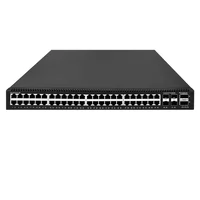 S3100-48T2Q4X, 48-Port Ethernet Switch, 48x 10/100/1000/2500/10G BASE-T RJ45, with 2x 40G SFP+ and 4x 1G/10G SFP+ Uplinks
$1095.00
S3100-48T2Q4X, 48-Port Ethernet Switch, 48x 10/100/1000/2500/10G BASE-T RJ45, with 2x 40G SFP+ and 4x 1G/10G SFP+ Uplinks
$1095.00
-
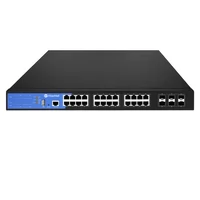 S3100-24T6X-P, 24-Port Ethernet Switch L3, PoE+ Switch, 24x 10/100/1000/2500 BASE-T RJ45, with 6x 1G/10G SFP+ Uplinks
$746.00
S3100-24T6X-P, 24-Port Ethernet Switch L3, PoE+ Switch, 24x 10/100/1000/2500 BASE-T RJ45, with 6x 1G/10G SFP+ Uplinks
$746.00
-
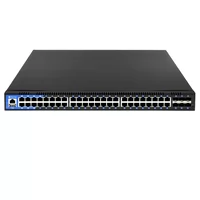 S3100-48T6X-P, 48-Port Ethernet Switch L3, PoE+ Switch, 48x 10/100/1000BASE-T RJ45, with 6x 1G/10G SFP+ Uplinks
$734.00
S3100-48T6X-P, 48-Port Ethernet Switch L3, PoE+ Switch, 48x 10/100/1000BASE-T RJ45, with 6x 1G/10G SFP+ Uplinks
$734.00
-
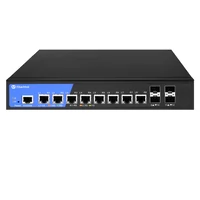 S3100-8T4X, 8-Port Ethernet Switch L3, 8x 10/100/1000/2500/10G BASE-T RJ45 Ports, with 4x 1G/10G SFP+ Uplinks
$398.00
S3100-8T4X, 8-Port Ethernet Switch L3, 8x 10/100/1000/2500/10G BASE-T RJ45 Ports, with 4x 1G/10G SFP+ Uplinks
$398.00
-
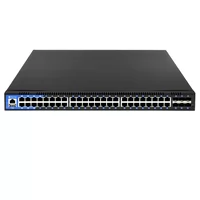 S3100-48T6X, 48-Port Ethernet Switch L3, 48x 10/100/1000BASE-T RJ45, with 6x 1G/10G SFP+ Uplinks
$365.00
S3100-48T6X, 48-Port Ethernet Switch L3, 48x 10/100/1000BASE-T RJ45, with 6x 1G/10G SFP+ Uplinks
$365.00
-
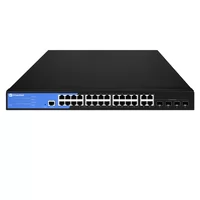 S2100-24T4TS-P, 24-Port Ethernet Switch L2+, PoE+ Switch, 24x 10/100/1000BASE-T RJ45, with 4x 1G RJ45/SFP Combo Uplinks
$360.00
S2100-24T4TS-P, 24-Port Ethernet Switch L2+, PoE+ Switch, 24x 10/100/1000BASE-T RJ45, with 4x 1G RJ45/SFP Combo Uplinks
$360.00
-
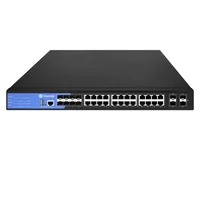 S3100-16T8TS4X, 16-Port Ethernet Switch L3, 16x 10/100/1000BASE-T RJ45, with 8 x 1Gb RJ45/SFP Combo and 4 x 1Gb SFP Uplinks
$340.00
S3100-16T8TS4X, 16-Port Ethernet Switch L3, 16x 10/100/1000BASE-T RJ45, with 8 x 1Gb RJ45/SFP Combo and 4 x 1Gb SFP Uplinks
$340.00
-
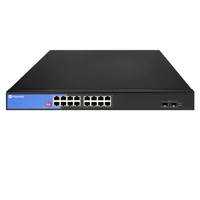 S2100-16T2S-P, 16-Port Ethernet Switch L2+, PoE+ Switch, 16x 10/100/1000BASE-T RJ45, with 2x 1G SFP Uplinks
$230.00
S2100-16T2S-P, 16-Port Ethernet Switch L2+, PoE+ Switch, 16x 10/100/1000BASE-T RJ45, with 2x 1G SFP Uplinks
$230.00
-
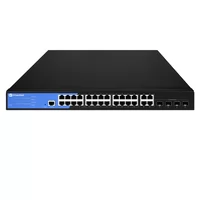 S2100-24T4TS, 24-Port Ethernet Switch L2+, 24x 10/100/1000BASE-T RJ45, with 4x 1G RJ45/SFP Combo Uplinks
$148.00
S2100-24T4TS, 24-Port Ethernet Switch L2+, 24x 10/100/1000BASE-T RJ45, with 4x 1G RJ45/SFP Combo Uplinks
$148.00
-
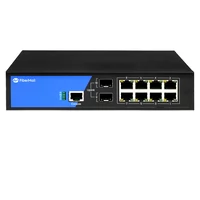 S2100-8T2S-P, 8-Port Ethernet Switch L2+, PoE+ Switch, 8x 10/100/1000BASE-T RJ45, with 2x 1G SFP Uplinks
$139.00
S2100-8T2S-P, 8-Port Ethernet Switch L2+, PoE+ Switch, 8x 10/100/1000BASE-T RJ45, with 2x 1G SFP Uplinks
$139.00
-
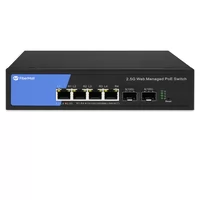 S3100-4T2X-P, 4-Port Gigabit Ethernet Managed Switch, PoE+ Switch, 4x 10/100/1000/2500 BASE-T RJ45, with 2x 1G/10G SFP+ Uplinks
$90.00
S3100-4T2X-P, 4-Port Gigabit Ethernet Managed Switch, PoE+ Switch, 4x 10/100/1000/2500 BASE-T RJ45, with 2x 1G/10G SFP+ Uplinks
$90.00
-
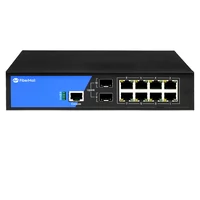 S2100-8T2S, 8-Port Ethernet Switch L2+, 8x 10/100/1000BASE-T RJ45, with 2x 1G SFP Uplinks
$71.00
S2100-8T2S, 8-Port Ethernet Switch L2+, 8x 10/100/1000BASE-T RJ45, with 2x 1G SFP Uplinks
$71.00
